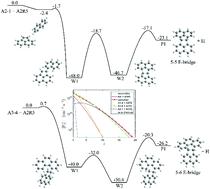当前位置:
X-MOL 学术
›
Phys. Chem. Chem. Phys.
›
论文详情
Our official English website, www.x-mol.net, welcomes your feedback! (Note: you will need to create a separate account there.)
On the mechanism of soot nucleation. II. E-bridge formation at the PAH bay.
Physical Chemistry Chemical Physics ( IF 3.3 ) Pub Date : 2020-07-08 , DOI: 10.1039/d0cp02554b Alexander S Semenikhin 1 , Anna S Savchenkova , Ivan V Chechet , Sergey G Matveev , Michael Frenklach , Alexander M Mebel
Physical Chemistry Chemical Physics ( IF 3.3 ) Pub Date : 2020-07-08 , DOI: 10.1039/d0cp02554b Alexander S Semenikhin 1 , Anna S Savchenkova , Ivan V Chechet , Sergey G Matveev , Michael Frenklach , Alexander M Mebel
Affiliation

|
A recently proposed mechanism of soot nucleation (M. Frenklach and A. M. Mebel, Phys. Chem. Chem. Phys., 2020, 22, 5314–5331) based upon the formation of a rotationally-activated dimer in the collision of an aromatic molecule and a radical leading to a stable, doubly-bonded E-bridge between them, rooted in the existence of a five-membered ring on the molecule edge, has been further investigated with a focus on the 5-6 E-bridge forming in the reaction of a PAH cyclopenta group with a bay site of another PAH. As a prototype reaction of this kind, we examined the reaction between 4-phenanthrenyl and acenaphthylene and, to project these results to larger aromatic structures, we also explored the size effect of the E-bridge forming reactions by computing the 1-naphthyl + acenaphthylene system and comparing these results with the prior results for pyrenyl + acepyrene. The two systems have been studied through high-level G3(MP2,CC)//B3LYP/6-311G(d,p) ab initio calculations of their potential energy surfaces combined with the RRKM/Master Equation calculations of reaction rate constants. With PAH monomers of similar sizes involved, the formation of E-bridge structures at the bay radical sites appeared to be faster and lead to increased nucleation rates as compared to the zigzag-forming ones. A model combining both the bay and zigzag rotationally-induced formation of E-bridges successfully reaches the level of nucleation fluxes comparable to those of the irreversible pyrene dimerization, thus affirming the rotationally-activated dimerization as a feasible mechanism for soot particle nucleation.
中文翻译:

关于烟灰成核的机理。二。PAH海湾的电子桥形成。
最近提出的烟灰成核机制(M. Frenklach和AM MEBEL,物理学。化学式化学物理。,2020年,22(5314–5331)是基于在芳香分子和自由基的碰撞中形成旋转活化的二聚体,从而导致它们之间形成稳定的双键电子桥,其根本原因是在其上存在五元环进一步研究了分子的边缘,着重研究了PAH环戊基与另一个PAH的海湾位点反应中的5-6 E桥形成。作为这类原型反应,我们研究了4-菲与and之间的反应,并将这些结果投射到更大的芳族结构中,我们还通过计算1-萘基+ ac而探索了电子桥形成反应的尺寸效应系统,并将这些结果与先前的enyl基+啶的结果进行比较。通过高级G3(MP2,CC)// B3LYP / 6-311G(d,p)对这两个系统进行了研究从头算出它们的势能面,再与RRKM /主方程的反应速率常数计算相结合。与之字形形成的PAH单体相比,在类似大小的PAH单体参与下,在海湾自由基位点上形成E桥结构似乎更快,并导致成核速率增加。结合了Bay和之字形旋转诱导的E桥形成的模型成功地达到了与不可逆pyr二聚作用相当的成核通量水平,因此肯定了旋转活化的二聚作用是烟尘颗粒成核的一种可行机制。
更新日期:2020-08-05
中文翻译:

关于烟灰成核的机理。二。PAH海湾的电子桥形成。
最近提出的烟灰成核机制(M. Frenklach和AM MEBEL,物理学。化学式化学物理。,2020年,22(5314–5331)是基于在芳香分子和自由基的碰撞中形成旋转活化的二聚体,从而导致它们之间形成稳定的双键电子桥,其根本原因是在其上存在五元环进一步研究了分子的边缘,着重研究了PAH环戊基与另一个PAH的海湾位点反应中的5-6 E桥形成。作为这类原型反应,我们研究了4-菲与and之间的反应,并将这些结果投射到更大的芳族结构中,我们还通过计算1-萘基+ ac而探索了电子桥形成反应的尺寸效应系统,并将这些结果与先前的enyl基+啶的结果进行比较。通过高级G3(MP2,CC)// B3LYP / 6-311G(d,p)对这两个系统进行了研究从头算出它们的势能面,再与RRKM /主方程的反应速率常数计算相结合。与之字形形成的PAH单体相比,在类似大小的PAH单体参与下,在海湾自由基位点上形成E桥结构似乎更快,并导致成核速率增加。结合了Bay和之字形旋转诱导的E桥形成的模型成功地达到了与不可逆pyr二聚作用相当的成核通量水平,因此肯定了旋转活化的二聚作用是烟尘颗粒成核的一种可行机制。


























 京公网安备 11010802027423号
京公网安备 11010802027423号